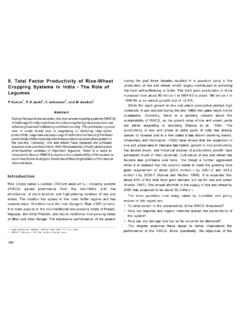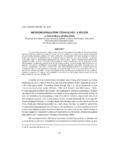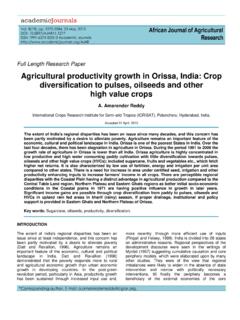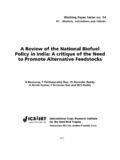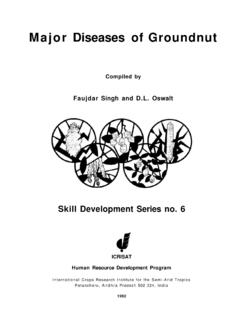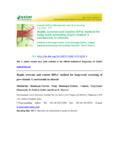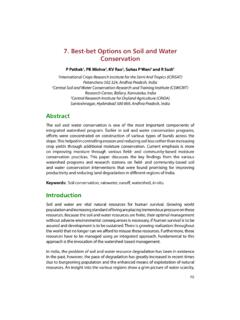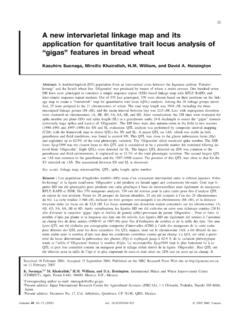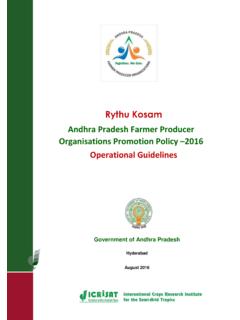Transcription of 1. Watershed Management Concept and Principles
1 1. Watershed Management Concept and Principles Suhas P Wani and Kaushal K Garg International Crops Research Institute for the Semi-Arid Tropics (ICRISAT). Patancheru 502 324, Andhra Pradesh, India Abstract Watershed is not simply the hydrological unit but also socio-political-ecological entity which plays crucial role in determining food, social, and economical security and provides life support services to rural people. The criteria for selecting Watershed size also depend on the objectives of the development and terrain slope. A large Watershed can be managed in plain valley areas or where forest or pasture development is the main objective.
2 In hilly areas or where intensive agriculture development is planned, the size of Watershed relatively preferred is small. Keywords: Watershed , consortium, community, water, livelihood. Introduction The rain-fed agriculture contributes 58 per cent to world's food basket from 80 per cent agriculture lands (Raju et al. 2008). As a consequence of global population increase, water for food production is becoming an increasingly scarce resource, and the situation is further aggravated by climate change (Molden, 2007). The rain- fed areas are the hotspots of poverty, malnutrition, food insecurity, prone to severe land degradation, water security and poor social and institutional infrastructure (Rockstorm et al.)
3 2007; Wani et al. 2007). Watershed development program is, therefore, considered as an effective tool for addressing many of these problems and recognized as potential engine for agriculture growth and development in fragile and marginal rain-fed areas (Joshi et al. 2005; Ahluwalia and Wani et al. 2006). Management of natural resources at Watershed scale produces multiple benefits in terms of increasing food production, improving livelihoods, protecting environment, addressing gender and equity issues along with biodiversity concerns (Sharma, 2002; Wani et al. 2003a,b; Joshi et al.
4 2005; and Rockstorm et al. 2007). History of Watershed Development Program in India About 60 per cent of total arable land (142 million ha) in India is rain-fed, characterized by low productivity, low income, low employment with high incidence of poverty 1. and a bulk of fragile and marginal land (Joshi et al. 2008). Rainfall pattern in these areas are highly variable both in terms of total amount and its distribution, which lead to moisture stress during critical stages of crop production and makes agriculture production vulnerable to pre and post production risk. Watershed development projects in the country has been sponsored and implemented by Government of India from early 1970s onwards.
5 The journey through the evolution of Watershed approach evolved in India is shown in Figure-1 (Wani et al. 2005 and 2006). Various Watershed development programs like Drought Prone Area Program (DPAP), Desert Development Program (DDP), River Valley Project (RVP), National Watershed Development Project for Rain-fed Areas (NWDPRA) and integrated Wasteland Development Program (IWDP) were launched subsequently in various hydro-ecological regions, those were consistently being affected by water stress and draught like situations. Entire Watershed development program was primarily focused on structural-driven compartmental approach of soil conservation and rainwater harvesting during 1980s and before.
6 In spite of putting efforts for maintaining soil conservation practices (example, contour bunding, pits excavations etc.), farmers used to plow out these practices from their fields. It was felt that a straightjacket top-down approach can not make desired impact in watersheds and mix up of individual and community based interventions are essential. Figure 1. Journey through Watershed approach in India (Wani et al. 2005 and 2006). 2. The integrated Watershed development program with participatory approach was emphasized during mid 1980s and in early 1990s. This approach had focused on raising crop productivity and livelihood improvement in watersheds (Wani et al.)
7 2006) along with soil and water conservation measures. The Government of India appointed a committee in 1994 under the chairmanship of Prof. CH Hanumantha Rao. The committee thoroughly reviewed existing strategies of Watershed program and strongly felt a need for moving away from the conventional approach of the government department to the bureaucratic planning without involving local communities (Raju et al. 2008). The new guideline was recommended in year 1995, which emphasized on collective action and community participation, including participation of primary stakeholders through community-based orgnizations, non-governmental organizations and Panchayati Raj Institutions (PRI) (GoI, 1994, 2008; Hanumantha Rao et al.
8 2000; DOLR, 2003; and GoI, 2008; Joshi et al. 2008). Watershed development guidelines were again revised in year 2001 (called Hariyali guidelines) to make further simplification and involvement of PRIs more meaningful in planning, implementation and evaluation and community empowerment (Raju et al. 2008) and guidelines were issued in year 2003 (DOLR, 2003). Subsequently, Neeranchal Committee (in year 2005) evaluated the entire government-sponsored, NGO and donor implemented Watershed development programs in India and suggested a shift in focus away from a purely engineering and structural focus to a deeper concern with livelihood issues (Raju et al.
9 2008). Major objectives of the Watershed Management program are: 1) conservation, up-gradation and utilization of natural endowments such as land, water, plant, animal and human resources in a harmonious and integrated manner with low-cost, simple, effective and replicable technology; 2) generation of massive employment; 3) reduction of inequalities between irrigated and rain-fed areas and poverty alleviation. What is Watershed Definition of Watershed A Watershed , also called a drainage basin or catchment area, is defined as an area in which all water flowing into it goes to a common outlet.
10 People and livestock are the integral part of Watershed and their activities affect the productive status of watersheds and vice versa. From the hydrological point of view, the different phases of hydrological cycle in a Watershed are dependent on the various natural features and human activities. Watershed is not simply the hydrological unit but also socio- political-ecological entity which plays crucial role in determining food, social, and economical security and provides life support services to rural people (Wani et al. 2008). 3. Delineation of Watershed Hydrologically, Watershed is an area from which the runoff flows to a common point on the drainage system.
